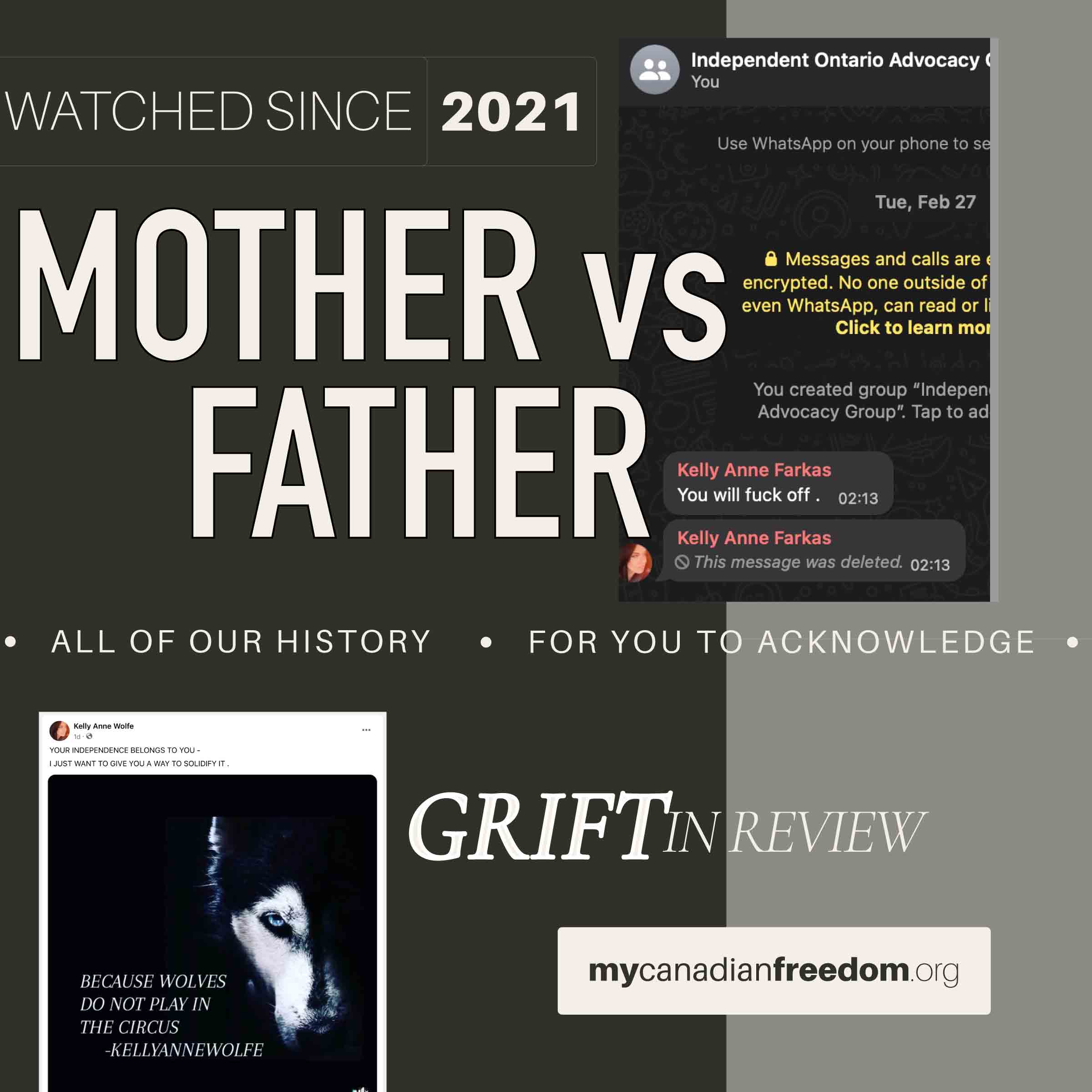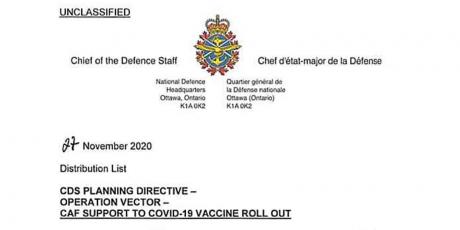Props to Canadian Military Family Magazine for the leak. But really, this is a more accessible format, guys. Download and share this leak at your will; give credit to JTFC and CMFM.
Editor: Including the auto-recognized version for SEO reason, and we'll tidy it up in the coming days.
Headquarters Quartier general 4th Canadian DiVision de la 4e Division du Canada Joint Task Force (Central) Force operationell1:1 interarmees (Centre)
itaire Loou The LCol Geo<ge Taylor Manege mili George
Denison Ill Armoury Taylor Denison Ill
1 Yukon Lane 1 Ruelle Yukon
Toronto, Ontario MJK OA1 Toronto, Ontario M3K OA1
3350-0p LASER 20-01 (COS)
May20
Distribution List
OP LASER-JTFC OBSERVATIONS IN
LONG TERM CARE F ACIL.fil_Q.:t:fl'.m_Q
References: A. Letter: Ontario Request for Assistance in Provincial Long Tenn. Care Facilities, Fed Min PS Blair to Ont SOLGEN Jones, 24 Apr 20; and B. 3350-1 (J33) JTF-LR T.sk Order 003 -JTFC Op LASER 20-01, 26 Apr 20.e
- Sir, as auth al Ref A and directed at Ref B, JTFC has employed Augmented Civilian Caree (ACC) teams, since 28 Apr 20, in five Province of Ontario-prioritized Long Tenn Care Facilitiese(LTCF) that were in urgent and immediate need of personnel to provide humanitarian relief andemedical support.
- Since arrival, and with the benefit of two weeks of observation, CAF ACC have identified a number of medical professional and technical issues present at the five LTCF. Fromea command and medical perspective, challenges were expected at these facilities given the severe deficiencies and shortfalls that existed/exist at the provincially-prioritized assignments; the CAFewas meant to go to locations with the greatest need of our support. This is a reflection of theeconditions at those distressed locatious. Consequently, issues and challenges have been collatedeand consolidated in medical reporting in the key areas of Standards and Quality of l\,fedical Care.
Annexes A-B provide detail by individual LTCF. The pwpose of this letter is to ensure that theseeobservations do not go unnoticed by our chain of command. the Province of Ontario, and mosteimportantly at the individual LTCf where efforts are currently underway in an open, tmnsparenteand collaborative manner at the local level between each LTCF and ACC to aid in recovery byeaddressing the specific areas of observation. - Nothing in this letter is meant to encroach upon the purview of the CAF Surgeon General, the established relationship between that office and the Chief Medical Officer of Health for Ontario, or the formal and informal connections by the CFHS and its offices, with those medical and professional Colleges and Associations that represent the medical professionals and health care capabilities within the Ontario health care system. Rather, this is meant to compliment that discussion by ensuring a command awareness on these issues so as to support the Surgeon General, the CFHS and our CAF medical and non-medical general duly personnel as they execute daily tasks as an ACC team in this unexpected and difficult operating environment.
- The Province of Ontario, and its Incident Mai1agemenl System (IMS) responsible to the Command Table and is responsible for dealing with the COVID crisis, co-chaired by the Provincial Deputy Ministers (DM) for both Health and for Long-Term Care, respectively, are aware that CAF ACC teams have made observations with Standards and Quality of Medical Care.
Informally, key figures in the IMS understand the general themes of our observations but have not been privileged with specifics or detail. We have sought to make observations that are strictly factual in nature and are not meant to assess or pass judgement on LTCF leadership or staffs.
From the perspective of our medical and non-medical personnel in-situ, however, the observations are sufficiently serious in nature to warrant them also being shared with the Province of Ontario, given that the CAF is responding to their RFA and LTCF fall under the Province's authority. I believe that this is best done under the Surgeon General's purview, and JTFC can enable that via our Regional Surgeon who has established links with the Provincial IMS Lead and Operations Head. Additionally, I will make myself available, should it be directed. or desired, to address these issues at my level, with my Provincial counterparts: DM for Health, DM for Long.Term Care, or with the Deputy Solicitor General for Ontario (Dep SOLGEN) who is responsible for RFA within the Province. - Far more importantly for the health of the residents who are the focus of all concerned, is our transparency and collaborative work with each LTCF to improve the situation so as to have an immediate effect on both daily operations and incremental facility recovery. To that end, I can assure that each ACC team bas addressed their own observations with the L TCF management and the competent medical authority available at each site. Every engagement to date has been positive with an acknowledgement by the LTCF that they need to improve, with the improvement on these observed issues being as equal in importance to: overall recovery as proper staffwg, suffici¥ent medical resources and supplies, coherent management return on site and establish a working connection to respective health networks.
- I believe care and attention by our ACC personnel remains our strongest tool in this domain. Notwithstanding the observed deviations in care and accepted practices, our CAF medical professionals lead by example in these LTCF and are ably supported by their non-medical general duty personnel and the structure of the Task Force that enables each ACC team. The content of the annexes was the result of the ACC Nursing Officer team leads, the work of the ACC Senior Nursing Officer, Capt K. Martin and the Regional Surgeon, LCol C. Mercer. Any specific interest with tbe Annex content is best directed via the Regional Surgeon as JTFC technical authority for the medical content.
- Sir, I remain available at your convenience for direction or discussion.
Respectfully,
C.J.J. Mialkowski
Brigadier General Commander
Annexes / Distribution List (next page)
Annexes
- Annex A-Observation Report on LTCF Eatonville Care Centre
- Annex B -Observation Report on LTCF Hawthorne Place Care Centre
- Annex C -Observation Report on IJTCF Orchard Villa
- Annex D-Observation Report on LTCF Altamont
- Annex E-Observation Report on LTCF Holland Christian -Grace Manor
Distribution List
- Action
- CJOC//Comd
- Information
- HQ CA//Comd/COS Ops/CA Surg
- CJOC//DGOps/Command Sutgeon/LEGAD
- CF H Svcs//Surg GeneraVDSG/DHSO
Annex A to Observation Report on LTCF Eatonville Care Centre
3350-0p LASER 20-01
14May20
EATONVILLE CARE CENTRE
420 THE EAST MALL. ETOBICOKE, ON M9B 3Z9
- I. Infection control:
- a. Isolation: COVID-19 positive residents allowed to wander. This means anyone in the facility (staff, residents, and vi,sitors) is at risk of being exposed and passing it throughout the home; as the resident's location is not predictable, full appropriate PPE is not possible;
- b, PPE practices-resident rooms: facility staff ae wder the impre.ssion that if the infection between 2 residents is the saine, there's no need to change their gown; and
- c. PPB practices -outside rooms: ¥ facility staff often wear PPE outside of rooms and at the nurses station.
- 2. Standards of practice/aualitv of care concerns:
- a. Reusing hypodermoclysis supplies even after sterility has been obviously compromised ( e.g. catheter pulled out and on the floor for an undetermined amount of tune);
- b. Poor palliative care standards -inadequate dosing intervals for some medications, some options limited based on level of staff administering medication ( ex: hydromorphone injection won't be given if RN unavailable);
- c. There are no mouth or eye care orders -or supplies for pa!lil!tive residents;
- d. Poor Foley catheter care. CAF SNO (Senior Nursing Officer) reports poor adherence to orders, no co.osistent safety checks. Significant incidents of excessive sediment or abnormal discharge and bleeding with no follow on action; and
- e. Generally very poor peri-catheterization care reported. Example: Retracting penis foreskin to clean isn't happening on a widespread level. CAF have fou.nd nearly a dozen incidents of bleeding fungal infections.
- 3. Supplies:
- a. General culture of featr to use supplies because they cost money (fluid bags, dressings, gowns, gloves ' etc);
- b. Key supplies are often under lock and ¥ key, not accessible by those who need them for work (e.g. wipes for PSWs); and
- c. Expired 1nedication. Much of the ward stock was months out of date (inference: residents have likely been getting expired medication for quite some tune).
- 4. Ambiguity on local practices:
- a. Extra soaker pad: residents who routinely soil their bed despite incontinence products are not pennitted to have an extra soaker pad or towel in bed to help protect sheets and blankets from soiling. (PS\Vs are afraid for their jobs on this ¥ issue) rationa!iilStiOu used is that an extra pad is undignified;
- b. Cohorting residents. Ministry requirement cited as reason they still have negative residents rooming with positive residents; and
- c. Unable to post information tbat would greatly increase patient safety and appropriate care. Example: an inconspicuous card above bed that stated code status, diet texture/fluid consistency, transfer status etc. ,vas deemed to be "undignified". This presents a safety risk to residents who may get improper care and liability risk to the care providers.
- 5. Communication:
- a. PS\Vs can be task focused and do not always report discovered abnonnalities to registered staff;
- b. Policies and facility-specific procedures aren't communicated to staff(example, how to sign for a narcotics shipment, what to do in the event of a call bell failure);
- Information about residents is difficult to access and hard to communicate ( example: a neurologic exam after a fall is hard to interpret when it's unclear what the resident's baseline neurologic status is);
- Information on LTCF COVID status (residents and staff) is not available or updated; and
- Management is unable to effectively enforce restrictions on use of CAF PPE. 6. Staffin.:
- a. New staff that have been brought to LTCF haven't been trained or oriented;
- b. LTFC is severely understaffed during day due to resident COinorbidities and needs (need more PSWs, RPN and RNs);
- MDs not present and have to be accessed by phone (not always within reach);
- Morale and well-being of staff at risk. Many are overworked, seem bwncd out and have no time off (some have not seen their families for weeks);
- e. The staffing is such that it is impossible to provide care at a pace that is appropriate to each resident or allow them any kind of independence. (example: a resident states he would like to ambulate to the toilet, a PSWs says, "110 I just changed him." Or people are often sedated with narcotics when they are likely just sad or depressed in a context where there isn't the staffing to support the level of care and companionship they need;
- f. ACC staff report not having witnessed any psychosocial support for th.ese residents who have all of a sudden had their families taken away (Reported as "It's heartbreaking to get a report about someone \Vho is "agitated and difficult'' and has been getting PRN narcotics or benzodiazepines to sedate them but when you talk to them they just say they're "scared and feel alone like they're in jail" -no agitation or sedationtrequired;and
- g. Gross in-adherence to some recurring orders ( example: regular vital signs or patient tu1ning); in some cases PSW$ are reported to asking ACC team members not to do these since they "wake up the resident".
- 7. Inanpro.,rjate Behaviour:
- CAF member have witnessed aggressive behaviour which ACC staff assessed as abusive/inappropriate. Incidents have been reported to management on numerous occasions. Witness reports have been completed and LTC ha$ commenced investigation to the knowledge of ACC staff. Examples include aggressiveness when changing incontinence product, not stopping or slowing when resident complained of pain, pulling residents, aggressive transfers impacting resident ability to participate in care as able (roll self in bed), degrading or inappropriate comments directed at residents etc; Annex ¥ A to Observation Report on LTCF
- b. Reports of inaccurate charting or documentation being amended by agency staff following submission regarding patient's pain levels, nutrition, eating status etc; and
- C. ACC staff report inaccurate reporting regarding resident's status to family (feeding, pain levels, general condition, etc).
- 8. ACC en2aeement with facili_ty --á staff:
- a. Concero.s were initially raised by the on-site SNO to local leadership. On 4 May 20, a telecoof was conducted between CO TBG I, OC ACC, and leadership from Eatonville Care Centre, as well as corporate management. Major concerns were raised, in particular staodards of care issues, poor IP AC, poor charting, narcotic misuse, and wound care. Concerns were raised in a collegial manner and facility staff advised they will address the deficiencies. ¥ Annex B to ObserVation Report on LTCF Hawthorne Place Care Centre
Annex A to Observation Report on LTCF Eatonville Care Centre
3350-0p LASER 20-01
14May20
EATONVILLE CARE CENTRE
420 THE EAST MALL. ETOBICOKE, ON M9B 3Z9
- 1. lnfectiOJ1 control:
- a. Numerous fans blowing in hallways (increased spread of COVID-19);
- b. Poor train.tog and adherence to 1P AC protocols noted;
- c. Significant deterioration of cleanliness standards throughout LTC;
- d. Adherence to IP AC BPG is severely impacted. All ACC and GD pers report n.ll!llerous incidents of PPE breakdown by LTC staff. Protocols in place have a near 100% contamination rate for equipment, patients and overall facility. Nurses/PSW s are often observed not changing PPB for several hours while moving betw(!etl n11merous paticmt rootn&, Equipment is seldom/ever observed to be disinfected but is used between +ve/-ve patients. Med cart, BP cuffs, thermometers etc. not disinfected between uses;
- e. Little to no disinfection had been conducted at the facilities prior to CAF operations. Significant gross fecal contamination was noted in numerous patient rooms;
- f. Insect infestation noted within LTC -ants and cockroaches plus unknown observed;
- g. Delayed changing soiled residents leading to skin breakdown; and N95s provided to staff witl.lout fit-test.
- 2. Standards of Practicef()ualilv of Care C9_nc.ernt
- a. Forceful and aggressive transfers, little/no regular turning of patients leading to increased number and complexity of pressure ulcers;
- b. Forceful feeding obl;erved by stiff causing audtl>le choking/aspiration, forceful hydration causing audible choking/aspiration;
- c. Patients observed crying for help with staff not responding for (30 min to over 2 hours);
- Narcotics are not considered a high alert medication therefore this -is no mandatory independent verification required within the LTC. High risk of dosing
- e. Activities of Daily Living-staff report residents having not been bathed for several weeks (noted at commencement of task);
- f. DNR status not posted call8ing staff to race to EMR during code! to determine DNR status. CPR has been initiated in absence of ability to verify DNR staf11s (likely futile, and also putting staff at risk as CPR is aerosol generating);
- g. Feeding status not posted/readily available. Given the lack of permanent staff or oversight, patient meals are often mixed up, with incidents of inappropriate meals being fed to residents with swallowing difficulties (increases likelihood of choking or aspiration);
- i. Access to PCC ( electronic health record) inconsistent and numerous reports of a lack of charting/documentation by staff causing significant gaps in information;
- j. Reports by SNO of little to no documentation on resident's status within EMR for up to 6 montbs. Unclear regarding reasons for lack of charting but resident's status indicated a requirement for additional information and documentation;
- k. Regular weUness ch cb suboptimal or inconsistent with staff resll.ltiog in many hours betw.een wel á á á s, cbecb, day/á ,._ght shift;
- 0 repo1 , .d jncidcnt of pati nti s mrt,end -6 á. _ d bottle n. being cl1 angcd for so longá the, contents á d become fuul ,and ooa,gulated; date and CJ(,piration of contents not note o . á .. á ttle;
- m, SNO report.ed incident ,of pennanent catheter b . iug in situ J weeks h e.yond schedmed chage date. Catheter was. c:hang d by SNO but stated documentation and adheremce to timeb . es ;vas pro biematic;
- n. Topical prescription :mediiein . shared betw,een residentsá a.nd
- o. Staff report signific.-t lack of appropriate wound care to advanced (stage 4Amsta_gcab1e) wounds du. to signific .. t skmtage of suppUes" lack of docum-f!;ntation.. ánon-st rile, teohnique1. :0 ápacking or impiop.r packing of \V-ou:nds.
- 3 .. Supplies
- a. áw 0110d . re supplies. insufficie or lock_ d away -mgh turnover of -tatr d lack or famil á arity áwith á á -led to poor practaees due to supply shortage;
- áb. á áo -ern,ih cart ava1!labfo for w:e w. -e event of a cardfoi. arres.
- Cm ,. Linen. shortage noted, Either more .-ens, need t,o be --cha_ , d or Jaundry staff _ :-. . red rot night shift. Shortage :d to :resá dents s eep á g ,on beds with no linen tea.din, to increased skin breakdown; and
- d. Av,ailabi .ity o iPads aá dl time constraints led to SLgni±ica, t lack of doCUIIllenta áon within BMR. Significant. aps in informatio -ex-is á .pec1aUy WR T pr ¥ sure ulcer progress,.. swellowin_g status or pati,em mental staru.s.
- 4. Ambiguity on local practices:
- a. .Palliative care ,orders Tlotá charted/unknown ro agency staff thus often not obsenred;
- Resident ceusu., ,and docum.en . ,TIOtl o-utdat-ed:; and
- c. ... Resident as.signmlmt is not clear for PSWs leadlng to residents"á..; , beá .. á , á'
- Communication:
- Poor communicatio between shifts...
- ., ainge led o
- 6. Staffing:
- a. No (oivil1an) R in _.he building o: her'thain sá .. ,o, dunng'week:ends. SNO and Execáu'tive Directur (afao, an RN only Rl{s on si e on .m.unerou oceaswo-ns du á . ¥á the week Significant resaltarnt. safety co-ncems regarding patient ratios (I RN for :'up t,o 200 pati.ts ).:
- b Litt] .'. ror no orientation forá new s J re8,Ulting in lo . adherence to protoc-ols or a ngruficmt . \ll'ID"C!JCSS of policy,
- Conta á . fonna ion and o -á. all schedu e not provided to unit s _ aff,cr-eates siginficant ddays f oru refe-rr_ai _ncl direction during, e ._ ergieD,cies.; Nursing .and ' . shift schedule poorly mnnag;ed. Brea.áá time is oot planne. the floor unatt -nde.
- d , á taff disappear and leaveá
- e. SNO reports that agency pulled back/rerouted RNs when they found out CAP members present resulting in regular degradation of patient ratios and instability of planning;
- f. No shift handover., witnessed since arriving on site;
- g. PSW often rushed and leave food on table but patients often cannot reach or cannot feed themselves (therefore they miss meals or do not receive meal for hours);
- h. Public inter-professional disputes amongst agency/permanent staff; and
- i. ACC personnel are heavily relied upon to train and mentor new staff;
- 7. ACC eneauement with fa.cilitv staff:
- a. Concerns were initially addressed by the on-site SNO to local leadership, including charge nurses. On 4 May 20, a teleconf was conducted between CO TBG 1, OC ACC, and leadership from Hawthorne Place, as well as corporate management.. Major concerns were raised, in particular standards of care issues, poor IP AC, poor charting, and narcotics misuse. Concerns were raised in a collegial lll.al!Jier and facility staff advised they ,viii address the deficiencies, however, given lack of resources available, they may have difficulty in affecting a plan.
Annex C to Observation Report on LTCF
Orchard Villa
3350-0p LASER 20-01
l4t1"fay 20
ORCHARD VILLA
1955 V AL_l.,!;Y FARM RD, ¥ . PICKER1NQ, ON LIV 3:8,.
- 1. J.!!fection control: MIC-
- a. Lack of cleanliness noted:
- I) -Cockroaches and flies present; and
- 2) Rotten food smell noted from the hallway outside a patient's room. CAF member found multiple old food trays stacked inside a bedside table.
- b. Inappropriate PPE use ntoted through.out all staff mg lovels ( doctors included); and Poor IPAC/PPE practices (double/triple gowning and masking, surgical mask
- a. Lack of cleanliness noted:
under N95, scarves under masks, etc).
2. Standar!J¤ of Practice/Oualitv of Care Concerns:
a. Patient's being left in beds soiled in diapers, rather than being ambulated to toilets;
b. Mouth care and hydration schedule not being adhered to;
c. Lack of proper positioning (head of the bed raised) for meals/fluids;
d. PSW and Nurse. aren't always sitting up residents before feeding/hydrating/giving meds; choking/atspiration risk is therefore high; includes observation of incident that appeared to have contributed in patient death ( code bJ11e due choking during feeding while supine -staff unable to dislodge food or revive resident);
e. Respecting dignity of patients not always a priority. Caregiver burnout noted amtong staff;
f. Unsafe nursing medication administration errors;
g. ' Staff putting food and important belongings outside of ¥ residents reach;
h. Nurses appear to document assessments without actually having assessed the . resident;
I. tucideut of likely fractured -hip not aclcfressed by staff; Med Tecb and SNO addressed and transferred resident to hospital;
j. Multiple falls, without requfred assessments following the fall;
k. Inconsistent and suboptimal assessment and treatment of pain; and
I. Lack of knowledge evident regarding ,vhat qualifies as a restraint. M1;1ltiple scenarios of walking aids being removed, or mattresses set on floor as patients were unable to stand from that lo,v position (to prevent them from wandering the facility).
3. Supplies:
a. Liquid oxygen generators not filled therefore not usable;
b. Limited and inaccessible wound care supplies;
c. Found I working suction locked in basement storage room; remaiuder of suction units not furtctional, last battery check was in 2014;
d. Oxygen concentrators not easily accessible.
e. Patients were sleeping on bare mattresses because of lack of access to , laW1diy/linens; and
f. Poor access to Iioens, soak.er pads, etc.
C -1/2
Local mirror of 20200514-CAF-JTFC-3350-OpLaser-20_01-20200529 enclosed below, or downloaded from this site.







Comments